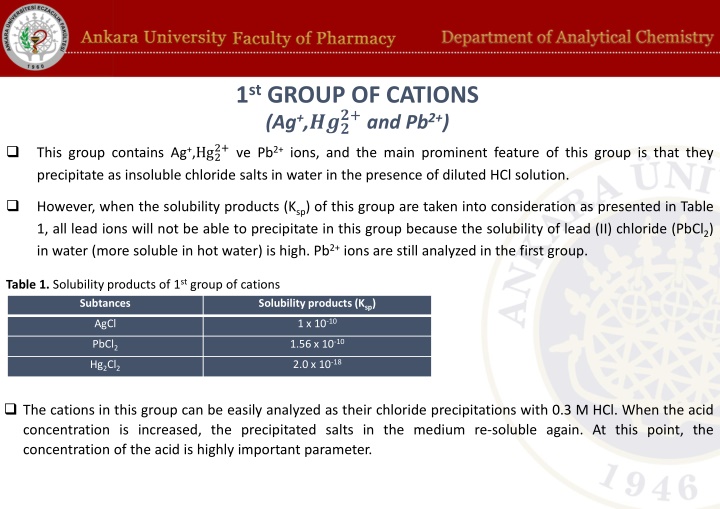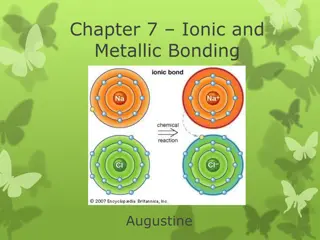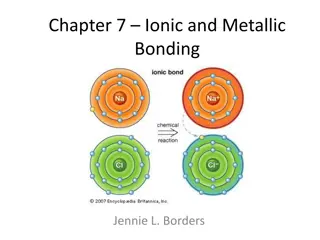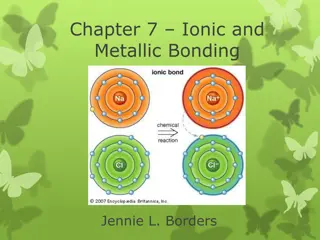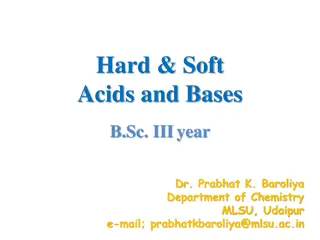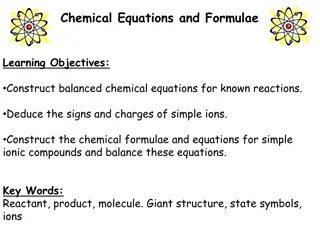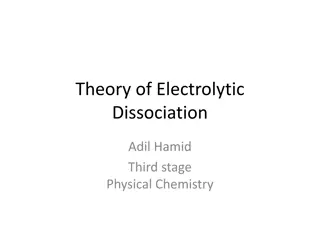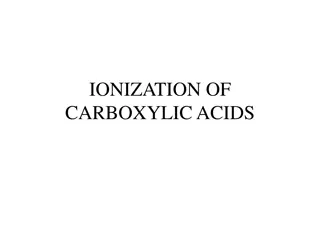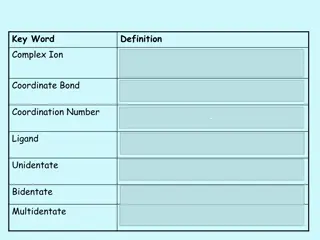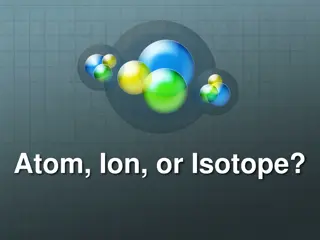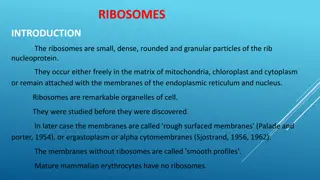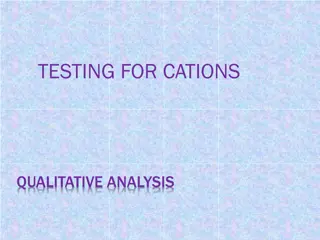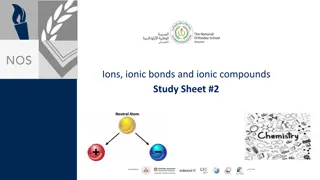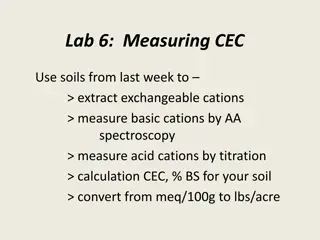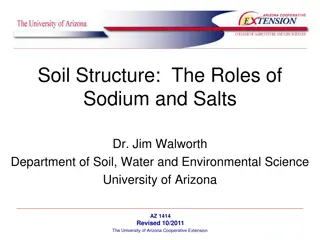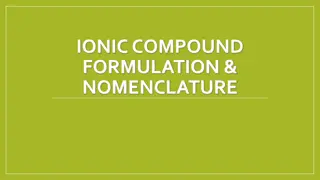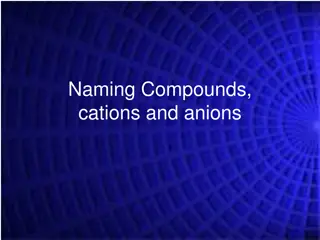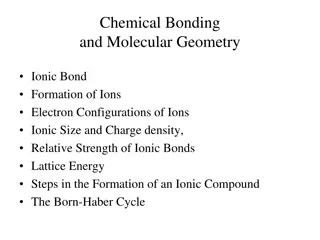Analysis of 1st Group of Cations: Ag+ and Pb2+ Ions
The analysis of cations in the 1st group involving Ag+ and Pb2+ ions is carried out by precipitating insoluble chloride salts in the presence of diluted HCl solution. The solubility products of AgCl, PbCl2, and Hg2Cl2 play a crucial role in the precipitation reactions. Various reagents such as HCl, NH3, KI, KCN, K2CrO4, and NaOH are used to identify and separate Ag+ and Pb2+ ions through distinctive color changes and precipitate formations. The process involves the formation of complex compounds and demonstrates the unique properties of each cation in the group.
Download Presentation

Please find below an Image/Link to download the presentation.
The content on the website is provided AS IS for your information and personal use only. It may not be sold, licensed, or shared on other websites without obtaining consent from the author.If you encounter any issues during the download, it is possible that the publisher has removed the file from their server.
You are allowed to download the files provided on this website for personal or commercial use, subject to the condition that they are used lawfully. All files are the property of their respective owners.
The content on the website is provided AS IS for your information and personal use only. It may not be sold, licensed, or shared on other websites without obtaining consent from the author.
E N D
Presentation Transcript
1stGROUP OF CATIONS (Ag+,??? 2+ve Pb2+ions, and the main prominent feature of this group is that they precipitate as insoluble chloride salts in water in the presence of diluted HCl solution. ?+and Pb2+) This group contains Ag+,Hg2 However, when the solubility products (Ksp) of this group are taken into consideration as presented in Table 1, all lead ions will not be able to precipitate in this group because the solubility of lead (II) chloride (PbCl2) in water (more soluble in hot water) is high. Pb2+ions are still analyzed in the first group. Table 1. Solubility products of 1st group of cations Subtances Solubility products (Ksp) 1 x 10-10 AgCl 1.56 x 10-10 PbCl2 2.0 x 10-18 Hg2Cl2 The cations in this group can be easily analyzed as their chloride precipitations with 0.3 M HCl. When the acid concentration is increased, the precipitated salts in the medium re-soluble again. At this point, the concentration of the acid is highly important parameter.
Ag+ ions assay Hydrochloric acid (HCl) solution: Ag+ ions (20 drops) precipitate as a white-colored chloride when 1 M HCl (4 drops) solution is added to the medium. Ag+ + HCl AgCl(k) + H+ (White) The resulting white-colored solution is centrifuged, and the precipitate is taken up from the media. NH3 (6 M) solution is added to the medium until AgCl is dissolved. AgCl precipitates dissolve as diammine complexes with NH3 solution. Ag(NH3)2+ + Cl- AgCI + 2NH3
Potassium iodide (KI) solution: Ag+ ions (20 drops) precipitate as yellow creamy silver iodide (AgI) when 1 M KI (4 drops) is added to the solution. Ag+ + KI AgI(k) + K+ (Yellow) Separate the filtrate from the resulting solution by centrifugation, and add 1 M KCN solution to dissolve the remaining precipitate. These processes indicate the presence of Ag+ ions in the medium. Potassium chromate (K2CrO4) solution: Ag+ ions (20 drops) precipitate as tile red colored silver chromate (Ag2CrO4) when K2CrO4 (4 drops) is added to the solution. 2Ag+ + CrO42- Ag2CrO4 (k) (Tile red) Sodium hydroxide (NaOH) solution: Ag+ ions (20 drops) precipitate as darkish-brown colored silver hydroxide (AgOH) when 1 M NaOH (4-5 drops) is added to the solution. However, the compound immediately decomposes into silver oxide (Ag2O) due to it s unstable. Ag+ + OH- AgOH (Darkish-brown) 2AgOH Ag2O + H2O (Black)
Pb2+ ions assay HClsolution: Pb2+ ions (20 drops) precipitate as white-coloured chloride forms when 1 M HCl (4 drops) solution is added to the medium. Pb2+ + 2HCl PbCl2 + 2H+ (White) The resulting white precipitate is separated from the solution by centrifugation, 2 mL of distilled water is added, and the mixture is heated in a water bath for 5 minutes. If the precipitate dissolves, there are Pb2+ions in the media. KI solution: Distilled water (20 drop) is added to the Pb2+sample solution (20 drops), and then 1 M KI (3-4 drops) is added to the resulting mixture. The yellow colored lead (II) iodide (PbI2) precipitate is obtained after the experimental process. Pb2+ + KI PbI2 + K+ (Yellow)
Thioacetamide (CH3CSNH2) solution: Distilled water (20 drops) is added to the Pb2+ sample solution (20 drops), and thioacetamide solution (3-4 drops) is added to the mixture. Then, the solution is heated in the water bath for 5 minutes. Pb2+ ions in the sample precipitate as black colored lead (II) sulfur (PbS). Pb2+ + H2S PbS (k) (Black) The resulting precipitate should dissolve in the 3 M HNO3solution. K2CrO4 solution: Pb2+ ions (20 drops) precipitate as yellow colored lead (II) chromate (PbCrO4) when K2CrO4 (3-4 drops) is added to the solution. Pb2+ + CrO42- (Yellow) PbCrO4(k)
Hg22+ ions assay HCl solution: Hg22+ ions (20 drops) precipitate as their white chloride salts when 3 M HCl (3-4 drops) is added to the solution. The resulting precipitate is insoluble in cold and hot water or diluted HNO3 solution, however, is soluble in NH3, concentrated HNO3 or aqua regia solutions. Hg22+ + 2 Cl- (White) Hg2Cl2(k) K2CrO4 solution: Hg22+ ions (20 drops) precipitate as reddish-brown mercury (I) chromate (Hg2CrO4) salt when K2CrO4 (3-4 drops) is added to the solution. Hg22+ + CrO42- (Reddish-brown) Hg2CrO4 (k)
KI solution: Distilled water (20 drops) is added to the Hg22+ sample solution (20 drops), and 1 M KI solution (4-5 drops) is added to the mixture. Yellow-green colored precipitate of mercury (I) iodide (Hg2I2) is obtained after this process. This precipitate is soluble when the excessive KI is added to the precipitate, however, insoluble in dilute acids. Hg22+ + 2KI Hg2I2 + 2K+ (Green-Yellow) Copper strip (Amalgam): Firstly, the copper wire (strip) piece is cleaned with 8-10 drops of concentrated HNO3 solution in the watch glass, then it is dried by filter paper and Hg22+ sample solution is added to the copper strip. Hg22+ ions coat the copper strip (bright gray colored).
